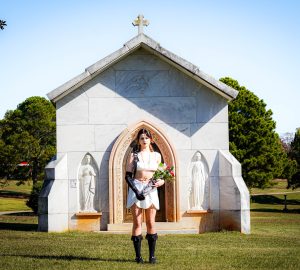Meet Claude Cahun: Shapeshifter and Surrealist Legend
Claude Cahun is what the kids would call a surrealist legend. Or a lesbo andryo clown core downtown weird girl for the social media inclined. Even the term “girl” feels wrong to write.
Claude Cahun pic.twitter.com/8YCp4KRKKJ
— G A B (@GABLABOR) August 15, 2023
Their past
Cahun never used language as explicit as nonbinary, but there’s a definite there (is this supposed to be “their”) there. In their autobiography, they referred to themselves as “neuter” and “queer freak.” This was pretty standard practice for someone who was situated when they were. Cahun’s life and career started at the beginning of the first wave of feminism and ended right before the second wave was ready to be super explicit about the gay question. As such, it’s not crazy to think of them as an early adopter of second wave feminism, but they most likely wouldn’t have a major platform to showcase it. The girls at the meets would have thought Cahun was weird. Again, a lesbo andryo clown core downtown weird girl. Especially since their views on their gender seemed to intertwine with their philosophical views.
Self Portrait, 1925 • Claude Cahun • pic.twitter.com/xoVMlmlQDB
— 𝑷𝒂𝒕𝒓𝒊𝒄𝒌 (@LKpaddy) October 26, 2023
Cahun was an anti-realist. Realism is the idea that the truth of a statement is defined by external factors. Therefore, anti-realism is the idea that the truth of a statement is determined by internal factors. There’s many offshoots, but Cahun’s seemed to be mainly to do with the self. And this idea that there can be multiple version of you, all living life at the same time. This is exemplified of course in how they choose to discuss in depict gender. Showing themselves and other figures once as women, then as men and then as something completely removed. But this idea could also fantastical.
‘Self-Portrait’,
— T. Talin d'Eyzac (@Ttalindeyzac) October 9, 2023
Claude Cahun, 1933 pic.twitter.com/6ugeUFVL5d
Occasionally, their self-portraits showcased them as a fairy or a vampire. Playing with the idea the idea of how much power our identities have in define our realities. This is some really hardcore gay theory, but they do a good job of communicating it in a way that doesn’t get too heady.
Understanding Cahun
Their work is notorious for a few key factors. Firstly, they tend to be straight on. Figures are using facing the camera, or at least their bodies are. Secondly, very simplistic backgrounds. Cahun also was very drawn to a vaudeville freak show aesthetic. So a lot of their work tends to have that bearded lady poster quality. Or in a lot of cases even more stripped down, literally just being figures in white and background fully black. Finally, they used the idea of the double a lot. Especially when photographing themselves.
@ Claude Cahun pic.twitter.com/eIDE4eWmEp
— Marin Favre (@MarinFavre) December 12, 2023
Sometimes this was achieved quietly simply by standing next to a mirror. Other times it would get complex by incorporating some double exposures. We even see them dabble into some graphic design work, rendering a full breakdown of the body and plastering the individualized parts on a flat plane together. The reason for these stylistic affinities should be obvious given what we’ve discussed. It ties back to the self, in particular the altering or the manipulation of the self and what can be done with that. Also, the mirroring showcases the idea of multiple selves, all of which are independent but inform the other.
Claude Cahun, 1927
— ★ 🅲🅾🅻🅸🅽 🆂🆃🅴🅴🆁 ★ (@colinphoenix) January 7, 2023
Self Portrait pic.twitter.com/yURWGZnhR9
Honestly, we could sit all day and breakdown their cool anti-war stuff from the 1940s or the collaboration they did with their wife. Or even create a direct correlation between the queer art they did in France with the queer uprising in New York around the late ’60s and early ’70s. But that would eat up every ounce of time you have, and so I employ you to just go check them out. Give it a go. Be gay, do crimes.





















